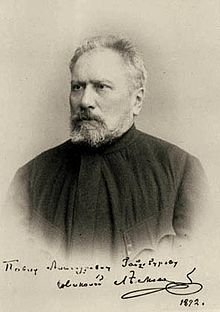Sheep
Schafochs , also Der Schafochs ( Russian Овцебык , Owzebyk ), is a story by the Russian writer Nikolai Leskow , which was completed on November 28, 1862 in Paris and was published in 1863 in the St. Petersburg Otetschestwennye Sapiski .
The Schafochs, a Russian intellectual - "a good person ... just went nuts" - finally puts an end to his life-long hard fate.
content
When the first-person narrator met the 28-year-old eccentric and cross-headed Vasily Petrowitsch Bogoslowski in Kursk in the summer of 1854 , he had long since left his nickname Schafochs , borrowed from an ox that Julian Simaschko had presented in his illustrated guide to zoology. Above all, the snail-shaped braids on the temples of the future friend were reminiscent of the horns of that animal.
Vasily had lost his father, a village sexton, early and only knew hardship. At the beginning of the 1850s, Wassili had completed the Kursk spiritual seminar. According to the wish of his constantly starving mother, the son should now work in the village as a priest at the side of a young wife. Vasili went to the Kazan Spiritual Academy . He broke off his studies there, got a position as private tutor, but voluntarily ended his employment after slapping the student for improper conduct. Vasily went back to Kursk, where - as indicated above - the narrator met him. There, the sheep ox is known as a drift who sometimes spends the night in the cornfield in summer. Often he lies down on an overgrown grave in the cemetery, looks at the sky or reads. The new private tutor position, which Vasily is aiming for, will not work and he will not get a job at the municipal recruiting office , although a former fellow student from the Kursk seminary, who is a civil servant there, supports him. Vasily wants to go to Perm . Before the sheep ox escapes from Kursk, the narrator asks him what he wants in a foreign country. From the sparse answer the narrator understands that he has an honest, fearless agitator in front of him who cannot come to terms with social conditions.
Vasily does not want to know anything about the Kursk women; with one exception. He leaves Lidotschka behind. The narrator loses sight of the sheep for three years.
In a hermitage, which is one of the numerous monasteries in the woods of the narrator's home, the next remarkable encounter takes place after another four years. Wassili's mother has since died in the poor house. In northern Russia to Vasily has in the woods near the Raskolniki hired as a servant, has for them in winter ancient Slavic capital letters copied and Halbmajuskeln. Vasily also did not get on with the Raskolnics and left the heretics; left his unfaithful wife Glafira Anfinogenova Mukhina in the village of Duby, left as he left every time. The Schafochs was later thrown out of a monastery because he wanted to improve the lot of "the humiliated and insulted of the monastery family".
The narrator places the homeless friend with the brandy distiller Alexander Ivanovich Swiridow, a former serf. Vasily sees the moneybag Swiridow as his enemy. When the sheep stirs up the "poor rabble" who works for Sviridow, they listen and then convey the message to the employer, it's over. The sheep hangs himself in the forest.
shape
Leskow writes from a distance. In other words, he actually knows very little about the taciturn protagonist, who repeatedly successfully eludes any observation. As Leskow lets the story run over many years, there are occasional encounters in their closer home that are worth telling.
reception
- 1959: Setschkareff thinks that Wassili fails because he is only concerned with ethical, not social values.
- 1967: Reissner writes: The protagonist, an intellectual loner, does not understand the world of those whose lives he wants to improve. So he is not understood, no one follows him and all that remains is suicide.
- 1988: Dieckmann writes: Leskov's friend, the ethnographer and writer Jakuschkin, was the model for the protagonist . Leskov's mosaic becomes a receptive painting through the skas .
literature
German-language editions
- Sheep. German by Günter Dalitz . P. 43–123 in Eberhard Reissner (Ed.): Nikolai Leskow: Collected works in individual volumes. Love in bast shoes. With a comment from the editor. 747 pages. Rütten & Loening, Berlin 1967 (1st edition)
Output used:
- Sheep. German by Günter Dalitz. P. 58–137 in Eberhard Dieckmann (Ed.): Nikolai Leskow: Collected works in individual volumes . Vol. 1: The Lady Macbeth from the Mtsensk district. Stories. 632 pages. Rütten & Loening, Berlin 1988 (1st edition), ISBN 3-352-00252-5
Secondary literature
- Vsevolod Sechkareff : NS Leskov. His life and his work. 170 pages. Verlag Otto Harrassowitz, Wiesbaden 1959
Web links
- The text
- Wikisource Овцебык (Лесков) (Russian)
- online at Lib.ru / Classic (Russian)
- online at RVB.ru (Russian)
- Entry in the Laboratory of Fantastics (Russian)
- The Schafoch's entry in WorldCat
Individual evidence
- ^ Reissner in the follow-up to the 1967 edition, p. 726, 4th Zvo
- ↑ Edition used, p. 106, 18. Zvo
- ↑ Russian Василий Петрович Богословский
- ↑ Russian Симашко, Юлиан Иванович
- ↑ Edition used, p. 78, 14th Zvu
- ↑ Edition used, p. 117, 1. Zvo
- ↑ Setschkareff, p. 41 below
- ^ Reissner in the follow-up to the 1967 edition, p. 726
- ↑ Dieckmann in the follow-up to the edition used, p. 613, 7. Zvo
- ↑ Russian Якушкин, Павел Иванович

